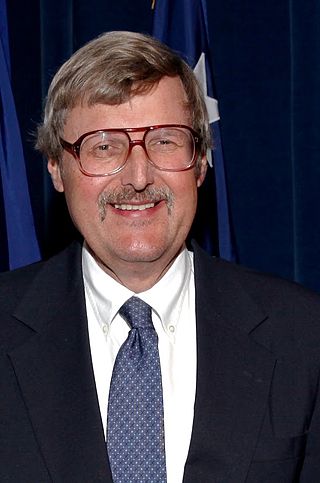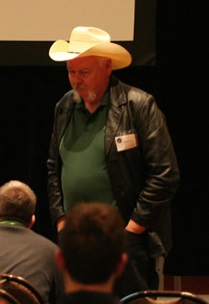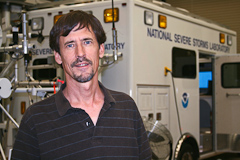
Roger A. Pielke Sr. is an American meteorologist with interests in climate variability and climate change, environmental vulnerability, numerical modeling, atmospheric dynamics, land/ocean – atmosphere interactions, and large eddy/turbulent boundary layer modeling. He particularly focuses on mesoscale weather and climate processes but also investigates on the global, regional, and microscale. Pielke is an ISI Highly Cited Researcher.
This is a list of meteorology topics. The terms relate to meteorology, the interdisciplinary scientific study of the atmosphere that focuses on weather processes and forecasting.
The Cooperative Institute for Severe and High-Impact Weather Research and Operations (CIWRO) is one of 16 NOAA Cooperative Institutes (CIs), hosted at the University of Oklahoma. Before Oct. 1, 2021, it was known as the Cooperative Institute for Mesoscale Meteorological Studies (CIMMS). The CIMMS/CIWRO, a research organization created in 1978 by a cooperative agreement between the University of Oklahoma (OU) and the National Oceanic and Atmospheric Administration (NOAA), promotes collaborative research between NOAA and OU scientists on problems of mutual interest to improve basic understanding of mesoscale meteorological phenomena, weather radar, and regional climate to help produce better forecasts and warnings that save lives and property. CIMMS/CIWRO research contributes to the NOAA mission through improvement of the observation, analysis, understanding, and prediction of weather elements and systems and climate anomalies ranging in size from cloud nuclei to multi-state areas.

The National Weather Center (NWC), on the campus of the University of Oklahoma, is a confederation of federal, state, and academic organizations that work together to better understand events that take place in Earth's atmosphere over a wide range of time and space scales. The NWC partners give equal attention to applying that understanding to the development of improved observation, analysis, assimilation, display, and prediction systems. The National Weather Center also has expertise in local and regional climate, numerical modeling, hydrology, and weather radar. Members of the NWC work with a wide range of federal, state, and local government agencies to help reduce loss of life and property to hazardous weather, ensure wise use of water resources, and enhance agricultural production. They also work with private sector partners to develop new applications of weather and regional climate information that provide competitive advantage in the marketplace.

The US National Center for Atmospheric Research is a US federally funded research and development center (FFRDC) managed by the nonprofit University Corporation for Atmospheric Research (UCAR) and funded by the National Science Foundation (NSF). NCAR has multiple facilities, including the I. M. Pei-designed Mesa Laboratory headquarters in Boulder, Colorado. Studies include meteorology, climate science, atmospheric chemistry, solar-terrestrial interactions, environmental and societal impacts.
The College of Atmospheric and Geographic Sciences at the University of Oklahoma consists of the School of Meteorology and Department of Geography & Environmental Sustainability (DGES). The college officially started on January 1, 2006, when it and the College of Earth and Energy were spun-off from the old College of Geosciences, which no longer exists.

In meteorology and climatology, a mesonet, portmanteau of mesoscale network, is a network of automated weather and, often also including environmental monitoring stations, designed to observe mesoscale meteorological phenomena and/or microclimates.

Ronald William Przybylinski was an American meteorologist who made important contributions to understanding of bow echoes, mesovortices, related quasi-linear convective system (QLCS) structures and processes, as well as QLCS related tornadoes. He also was an expert on technical aspects of weather radar and applications to both operational meteorology and research.

Charles A. Doswell III is an American meteorologist and prolific severe convective storms researcher. Doswell is a seminal contributor, along with Leslie R. Lemon, to the modern conception of the supercell, which was developed originally by Keith Browning. He also has done research on forecasting and forecast verification, especially for severe convective storms, and is an advocate of ingredients-based forecasting.

The Verification of the Origins of Rotation in Tornadoes Experiment are field experiments that study tornadoes. VORTEX1 was the first time scientists completely researched the entire evolution of a tornado with an array of instrumentation, enabling a greater understanding of the processes involved with tornadogenesis. A violent tornado near Union City, Oklahoma was documented in its entirety by chasers of the Tornado Intercept Project (TIP) in 1973. Their visual observations led to advancement in understanding of tornado structure and life cycles.
Howard Bruce Bluestein is a research meteorologist known for his mesoscale meteorology, severe weather, and radar research. He is a major participant in the VORTEX projects. A native of the Boston area, Dr. Bluestein received his Ph.D. in 1976 from MIT. He has been a professor of meteorology at the University of Oklahoma (OU) since 1976.

Roger M. Wakimoto is an atmospheric scientist specializing in research on mesoscale meteorology, particularly severe convective storms and radar meteorology. A former director of the National Center for Atmospheric Research (NCAR), Wakimoto in November 2012 was appointed as assistant director of the Directorate for Geosciences (GEO) of the National Science Foundation (NSF).

Erik Nels Rasmussen is an American meteorologist and leading expert on mesoscale meteorology, severe convective storms, forecasting of storms, and tornadogenesis. He was the field coordinator of the first of the VORTEX projects in 1994-1995 and a lead principal investigator for VORTEX2 from 2009-2010 and VORTEX-SE from 2016-2017, as well as involved in other smaller VORTEX offshoots and many field projects.

Paul M. Markowski is an American meteorologist and leading expert on tornadogenesis and the forecasting of supercells and tornadoes.
The following is a glossary of tornado terms. It includes scientific as well as selected informal terminology.

Louis John Wicker is an American atmospheric scientist with expertise in numerical analysis, numerical simulation, and forecasts of severe convection and tornadoes. Doing storm chasing field research, Wicker deployed the TOtable Tornado Observatory (TOTO) and was in leadership roles in the VORTEX projects. He is also known for pioneering work simulating convection at the National Center for Supercomputing Applications (NCSA) at the University of Illinois at Urbana–Champaign (UIUC).

Adam James Clark is an American meteorologist at the Cooperative Institute for Mesoscale Meteorological Studies (CIMMS) and the National Severe Storms Laboratory (NSSL) recognized for contributions to numerical modeling of convection.

Donald W. Burgess is an American meteorologist who has made important contributions to understanding of severe convective storms, particularly tornadoes, radar observations and techniques, as well as to training other meteorologists. He was a radar operator during the first organized storm chasing expeditions by the University of Oklahoma (OU) in the early 1970s and participated in both the VORTEX projects.

Robert A. Houze, Jr., is an American atmospheric scientist, researcher, author, and Professor Emeritus of Atmospheric Sciences at the University of Washington where he led a research team known as the Mesoscale Group for 46 years. He and his group participated in international field projects around the world and global satellite programs employing weather radar and aircraft in the tropics and midlatitudes, in projects sponsored by NSF, NASA, DOE, and NOAA. Houze has been on the science teams for three NASA satellites for the global study of clouds and precipitation. The predominant areas of his research are tropical convective clouds, extreme storms, flooding in the Asian Monsoon, tropical cyclones, and midlatitude frontal systems in mountainous regions.













